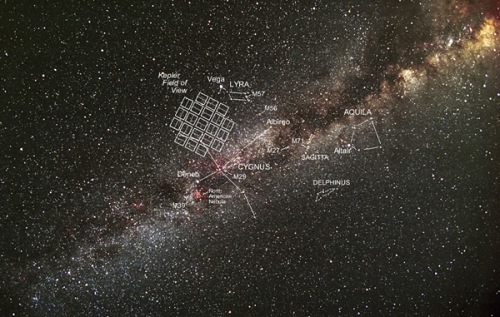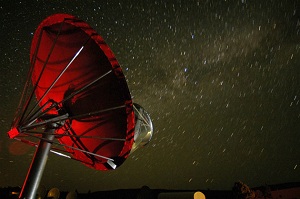Centauri Dreams
Imagining and Planning Interstellar Exploration
A Jittery Problem for Kepler
We’ve been assuming all along that it would take the Kepler mission three years-plus to detect true Earth analogues, meaning planets orbiting Sun-like stars at about the Earth’s orbital distance. Now it turns out that figure may have to be extended, as this article in Nature makes clear. Author Ron Cowen points out that a close analysis of approximately 2,500 of the tens of thousands of stars in the Kepler field are flickering more than expected, and that spells trouble.

Image: Kepler’s field of view superimposed on the night sky. Credit: Carter Roberts.
The reason: The dip in starlight signalling the presence of a planet can be masked by the unexpected noise in the Kepler data. As described by Kepler scientist Ron Gilliland (Space Telescope Science Institute), the signal of an Earth analogue — assuming a star much like the Sun — should be a drop of about 85 parts per million when the planet passes in front of its star, lasting a statistical average of 10 hours, and occurring once per year. Moreover, the signal would only be evident after three successive transits, equally spaced in time, had been observed.
But that assumption was made with luminosity fluctuations about the same as the Sun’s. The noise metric the Kepler team uses is called Combined Differential Photometric Precision, or CDPP, and according to Gilliland and colleagues in the paper on this matter, CDPP was intended to be about 20 ppm for dwarf stars at 12th magnitude. But CDPP turns out to be 30 ppm, 50 percent higher than expected. The paper goes on to demonstrate that most of the noise is intrinsic to the stars themselves rather than being the result of instrument problems.
From the paper:
Kepler… is the first mission capable of quantifying the variability of large numbers of stars to the small levels by which the Sun is known to vary. Kepler will continue to provide exciting new insights into the astrophysics of quiet stars, and their galactic distributions. While we are not surprised to have learned new things from this new observational capability, the fact that the stars are more variable than expected has a significant influence on the ability to readily detect Earth-analog planet transits where the expected signal per transit is only a few times the inferred noise level on comparable time scales. Observing for a longer time baseline can compensate for the loss of transit detection sensitivity from the higher than anticipated stellar noise.
A longer time indeed, the upshot being that Kepler will need not three but an average of six transits per planet to adequately verify that the change in starlight is actually a planet. Finding the Earth analogues among the Kepler stars, then, calls for an extended mission, and that will more than double the planned mission life of three and a half years. Cowen quotes Kepler chief data analyst Jon Jenkins as saying that while an overall eight year mission now seems necessary, the extension to the mission is by no means assured. After all, NASA’s budget problems include the costs of the James Webb Space Telescope, and Kepler could be squeezed out of the picture.
Magnetic activity on the Kepler stars may be the reason for the unexpected noise in the data, and if that is the case, it may be because the stars are young, thus spinning faster and feeding a more powerful magnetic field. That runs against predictions that most of the stars in the sample would be older than the Sun, but right now the cause seems less important than the need to get Kepler the extended mission it needs to actually tell us something about the distribution of Earth-like worlds in a large sample of stars. It would be outrageous if Kepler were to be shut down when it was just a few years away from answering such long-held questions, but at the moment NASA isn’t talking about Kepler’s chances. That decision will come next spring.
The paper is Gilliland, “Kepler Mission Stellar and Instrument Noise Properties,” accepted by the Astrophysical Journal (preprint). Thanks to Antonio Tavani for the original link to the Cowen article.
Related: “On Monday, 12 September 2011, astronomers will report significant new results in the field of exoplanets, obtained with the High Accuracy Radial Velocity Planet Searcher, better known as HARPS, the spectrograph on ESO’s 3.6-meter telescope at La Silla Observatory in Chile.” More here.

If You’re Going to the Starship Conference…
Quite a few people involved with Tau Zero and many of the Project Icarus team are planning to be in Orlando at the end of the month for the 100 Year Starship Symposium. I know about most of these, but if you haven’t already told me that you are planning to attend, please leave me a note in the comments to this post. I’m looking forward to meeting many Centauri Dreams readers there.

A New Mechanism for Supernovae
Are dozens of Type Ia supernovae waiting to happen within a few thousand light years of the Earth? New research from the Harvard-Smithsonian Center for Astrophysics suggests the answer is yes. Type Ia events are thought to occur when a white dwarf accretes material from a companion star. The idea is that the white dwarf — a stellar remnant that is no longer capable of fusion — eventually exceeds the so-called Chandrasekhar mass, roughly 1.4 times the mass of the Sun. When a star pushes past the limit, gravity compacts the dwarf to the point of runaway nuclear fusion, and a spectacular stellar event appears in the heavens.

Type Ia supernovae are a well studied phenomenon, but a continuing problem with these events is that the scenario doesn’t quite explain everything we see, or don’t see. Most Type Ia supernovae show none of the hydrogen and helium near the explosion that we would expect. As this news release from the CfA notes, the gas should be there, in the form of remnant materials that had not yet been accreted by the white dwarf at the time of the explosion, or possibly left behind by the disruption of the companion star during it. Where is the missing gas?
Image: New research shows that some old stars known as white dwarfs might be held up by their rapid spins, and when they slow down, they explode as Type Ia supernovae. Thousands of these “time bombs” could be scattered throughout our Galaxy. In this artist’s conception, a supernova explosion is about to obliterate an orbiting Saturn-like planet. Credit: David A. Aguilar (CfA).
Rosanne Di Stefano and colleagues are now examining a new mechanism for such supernovae, one in which the spin of the white dwarf would explain the lack of hydrogen and helium. The work notes that a white dwarf gains angular momentum as it gains mass. Get it rotating fast enough and the additional spin can help to support it, so that it crosses the barrier of 1.4 solar masses and becomes a super-Chandrasekhar-mass star.
Eventually accretion will stop and the white dwarf will begin to slow down. When the spin is no longer sufficient to counteract the effects of gravity, the Type Ia supernova occurs. It’s an ingenious solution, and because the spin-down process could create an interval of as much as a billion years between the 1.4 solar mass point and the ensuing explosion, it would explain the dissipation of materials, and allow time for the companion star to evolve into a second white dwarf.
From the paper:
Conservation of angular momentum plays an important role in astrophysics. It allows NSs and black holes to be spun up to near maximal rotation. It seems almost certain that WDs can be similarly spun up. Indeed, given the variety of donors and accretion geometries exhibited in nature, spin-up can fail only if there is a fundamental physical principle that disallows it. As long as spin-up to near-maximal rotation occurs, some of the effects we discussed will occur. Although theoretical uncertainties make predictions difficult, we have shown that spin-up/spin-down has testable consequences. The measurements we propose can therefore provide input for theoretical work.
Take the estimate of three Type Ia supernovae every thousand years in our galaxy and the calculations of Di Stefano’s team are that there are probably dozens of such pre-explosion systems within several thousand light years of the Sun. “We don’t know of any super-Chandrasekhar-mass white dwarfs in the Milky Way yet, but we’re looking forward to hunting them out,” says Di Stefano’s colleague and co-author Rasmus Voss (Radboud University, Nijmegen, The Netherlands). Wide-field surveys like Pan-STARRS and the Large Synoptic Survey Telescope should help us detect supernova precursors like these for study in depth.
The paper is Di Stefano and Voss, “Spin-Up/Spin-Down models for Type Ia Supernovae,” Astrophysical Journal Letters, (preprint).

The Asteroid Deflection Gambit
We’ve talked often in these pages about Near Earth Objects (NEOs) and the potential danger posed not just by them but by objects from much further out in the Solar System if they were to take an Earth-crossing trajectory. But it’s also true that NEOs have a certain allure even if they are potentially dangerous. They’re close enough to consider a manned mission, and even a small 2-kilometer sized metallic NEO could contain rich metals and minerals worth trillions of dollars. Of course, what metals markets would do if we suddenly had access to such an object is another matter. And mining an NEO, not a new concept, is still on the impractical side.
But Hexi Baoyin (Tsinghua University, Beijing) and colleagues are proposing a possible solution. The temporary capture into Earth orbit of an NEO by creating a small velocity change could allow a relatively low-cost trajectory to the object that would provide mining opportunities. And indeed, various asteroid deflection schemes from solar radiation to nuclear explosions are available in the literature, most considered in terms of saving our planet from an impact. The authors of this new paper (thanks to Phil Mowatt for the tip) have set about identifying what it would take to capture an NEO to Earth orbit, using as their case in point a periodic comet called 39P/Oterma.
It’s an interesting object, this Oterma, one that sometimes is captured by Jupiter for one to several orbits. Call it a ‘temporary moon.’ In the same way, the authors believe that ‘a small velocity increment’ would be enough if exerted in the right place to cause the temporary capture of a NEO in Earth orbit. They acknowledge that the method would work only for small NEOs, based on our current technology, with the larger ones being too heavy for significant change to their orbital energy.
How to cause the desired effect? The authors look at alternatives from nuclear explosions and kinetic impactors (impulsive) to Yarkovsky effect, focused solar, gravity tractor, mass driver, pulsed laser and space tug (slow push) before settling on one from the first camp:
Considering the required impulsive velocity increment is not so small and the diameter of NEOs is relatively large, there are two impulsive capture methods available, kinetic impactor and nuclear explosion, but they are never tested or applied. Among them, the nuclear explosion method may not be proper one for the mentioned small NEO, because the nuclear explosion can release a very large amount of energy, the result may be a fragmentation of the target NEO. So the kinetic impactor is often considered as a better maneuver means especially for the NEOs smaller than 50 meters in diameter.
So we’re talking about a space probe or projectile that would hit the NEO at high velocity and change its orbit. A possible candidate is the smallish asteroid 2008EA9, but the list of candidates is growing as our surveys continue. The new orbit would be a temporary one but would allow a prolonged period of study and, possibly, exploitation of resources there. All of which jogged my memory of Carl Sagan’s work with JPL’s Steven Ostro on precisely these matters. One paper devoted to the problem was “Cosmic Collisions and the Longevity of Non-Spacefaring Galactic Civilizations” (citation below). Two matters come to mind in relation to it, the first being the need to deal with space debris over the long haul, which Sagan and Ostro handle thusly:
Sooner or later human civilization must confront the asteroid/comet collision hazard or become extinct. Dealing with interplanetary collision hazards over a period of centuries or millennia will naturally take our spacefaring society further out into the solar system — if for nothing else, to improve surveillance of incoming comets. As technology advances and the life-span of our species (and its successors) lengthens, a slow outward transition from interplanetary travel towards cometary source regions and interstellar spaceflight seems conceivable.
That’s a ‘meme’ that Centauri Dreams has been working with for the past seven years, that interstellar flight will grow organically out of the need to extend infrastructure outwards in the Solar System rather than through an interstellar project mounted Apollo-like on its own. The second issue, though, is much more troubling. Sagan and Ostro again:
… altering the trajectories of objects in nearby interplanetary space can introduce perils on timescales much shorter than the average intervals between natural impact catastrophes… Thus, interplanetary collision hazards may act as a kind of sieve, simultaneously requiring civilizations to become spacefaring and to institute stringent controls on the misuse of orbit-engineering technology. These joint constraints may or may not be so severe as to truncate the longevity of spacefaring civilizations below the timescales for civilization-ending impacts themselves. One way or another, interplanetary collisions constitute a unique, exogenous environmental factor in the natural selection of long-lived civilizations.
I’m thinking that Sagan and Ostro had the matter precisely right. Whether through simple error or the calculated decision to use a small NEO as a weapon, the dangers of asteroid deflection for research and mining seem not to merit the risk. I’ll buy the notion that getting to an asteroid with robotic probes or manned missions makes sense as we continue to assess the potential threat they may pose, but let’s reach them without trying to tug them into new trajectories. As Sagan and Ostro noted some time ago, we’re about at the point where we have the technology to alter an asteroid orbit. And as Sagan wrote in Pale Blue Dot (1994), “If we’re not careful, many nations may have these capabilities in the next few decades. What kind of world will we then have made?”
The paper is Baoyin et al., “Capturing Near Earth Objects,” accepted for publication in Research in Astronomy and Astrophysics (Chinese Journal of Astronomy and Astrophysics). Preprint available. The Sagan and Ostro paper is “Cosmic Collisions and the Longevity of Non-Spacefaring Galactic Civilizations,” JPL TRS 1992+, available online. See also Sagan, “Dangers of Asteroid Deflection,” Nature 368, Issue 6471 (1994), p. 501.

SETI and the Use of Tools
It makes perfect sense to me that we usually think of extraterrestrial intelligence in terms of technology. After all, when we listen to the stars for the whisper of a distant signal, we’re saying that SETI is all about finding something that was produced with tools, like a beacon. Or if we extend the thought to science fiction, we might dream of studying alien civilizations through their ruins on long-dead worlds, learning about them by studying what they once built.
After all, this is how we do archaeology, digging up spear-points or the bricks of ziggurats, the things that a culture leaves behind that it built with its tools. But will we always confine the idea of intelligence to the presence of an artifact? Science writer and Astronomy Now editor Keith Cooper examines the question in Dolphins, Aliens, and the Search for Intelligent Life, an incisive new essay for Astrobiology Today, one that offers us a new technology that may prove that intelligence doesn’t necessarily need tools.
CHAT — Cetacean Hearing and Telemetry — is a device built to help humans communicate with dolphins. So far we’ve been able to determine that dolphins do some extremely interesting things from the standpoint of possible language. They can emit whistles and barks, use echo location, and seem to understand a basic syntax, which might flag, for example, the difference between a statement and a question, or differentiate between a past or future tense.
The Nature of a Signal
Some researchers call this a language (whales have many of the same traits), while others call it ‘referential signaling,’ as Cooper explains. Such signaling would involve tagging things with names, but whether or not it indicates a deeply interactive language is another issue entirely. Maybe CHAT can help make the call. It’s a device worn around a diver’s neck, connected to a pair of hydrophones and a simple keyboard that can be used with one hand. The idea is to sidestep the issue of whether dolphin ‘language’ can be translated by setting up the option of a common artificial language that both humans and dolphins could use.

The device is to be tested this year and put into field use in 2012, so we may start to get some results fairly soon. While we await early findings, Cooper talks about Robin Dunbar’s ideas on the social nature of intelligence. Dunbar (University of Oxford) looked at intelligence evolving out of social practice, seeing it as a way for animals not only to survive but prosper in complex social groupings. Let me quote Cooper on this:
These include notions of reciprocal altruism (I scratch your back, you scratch mine), politics (forming sub-groups and coalitions within the larger group) and understanding the emotions of others (empathy, which in turn relies on theory of mind, the ability to be aware of one’s self and others). Looking at it that way, modern social networking on media such as Facebook may just be a symptom of what helped drive us to become intelligent in the first place, many tens of thousands of years ago.
And this takes us back to questions about things like SETI, because we are, after all, talking about how individuals make sense to each other:
Here’s the trick — to be social, you must be communicative. Staying quiet is anti-social. Personal interactions require communication, of some form, and the more complex the interaction, the more complex the communication. So if intelligence and social behavior is linked — and many people agree that it is — then the best place to start looking for intelligence is in animals that like to chat with one another.
Language and Silence
Which circles us back to dolphins, of course, but leave me wondering just what to make of this in a cosmic sense. I grew up being enthusiastic about SETI ever since, as a teenager, I read about Frank Drake’s work at Green Bank, which began in 1960. The idea of researchers scanning the skies for signals seemed so intuitively right that in my naïveté, I assumed we’d track down a confirmed beacon within just a few years.
No such luck, and in the many years since we’ve looked not only at how mind-bogglingly difficult the SETI hunt is at radio frequencies, but how restricting it is to think that an advanced civilization would use radio in its communications in the first place. Now we have to confront the possibility that extraterrestrial intelligence may not be rare at all, but that it may not necessarily lead to tool-building and hence beacons.
Cooper’s essay is just terrific, especially insofar as it gets into Claude Shannon’s 1940s work on the nature of signals, which is so crucial to how we understand data and language (or maybe I should say ‘language as data’). I’ll leave the pleasure of reading Keith’s presentation of Shannon to you because you’ll want to read the whole essay. But it’s worth noting in the SETI context that putting dolphin whistles through Shannon’s information theory demonstrates an internal structure in dolphin communications, while Shannon’s ideas on entropy and language — which focus on language as order and probability — show promising possibilities for dolphin intelligence, although everyone notes the need for more data.
Let’s say, then, that if intelligence is as much about communication as technology, then social behavior may well be the driver on many worlds, where intelligent beings may contemplate the universe without ever developing slide rules or computers or radio transmitters. Perhaps SETI is best considered as SETT — the Search for Extraterrestrial Technology — while intelligent cultures flourish undetected.
Learning more about how species on our own planet use their intelligence, and discovering what sort of linguistic capabilities they actually have, will eventually help us sort out the possibilities. Not everyone agrees that dolphins possess the kind of intellect that could summon up a true language. What a conundrum — we’re not sure whether or not we’re the only ‘intelligent’ species on our own planet. How little we know about intelligence elsewhere in the cosmos!

SETI: Let the Search Continue
Most people think that SETI is worth doing, whether or not they actually believe there are other technological civilizations in the galaxy. Ben Zuckerman, a professor of astronomy at UCLA, is certainly in the skeptics’ camp, thinking there are no technological ETs in the Milky Way, but he’s quoted in this story from QUEST (KQED San Francisco) as calling for more SETI. “Given that the costs are not very high,” says Zuckerman, “why not continue the search?” Zuckerman, who once worked with Carl Sagan in graduate school, no longer thinks we live in a crowded galaxy, but a potential discovery of this magnitude justifies the relatively modest expenditure.

It’s not surprising to find Jill Tarter echoing Zuckerman. The recent funding problems of the Allen Telescope Array have not daunted the woman who more than anyone else has come to represent the search for other intelligent life. And although she believes we may one day come to the ‘extraordinary conclusion’ that we really are alone, the time for drawing that conclusion is hardly near. We have hundreds of billions of stars to choose from in the Milky Way and hundreds of billions of galaxies beyond our own, and in those terms, we’ve barely begun to search.
Image: SETI searcher Jill Tarter. Credit: Sven Klinge.
The KQED story takes note of the new element in SETI research, which has to do with the Kepler mission. With the discovery of more than a thousand planets orbiting stars in its field of view, Kepler may well have found the first true Earth analogues — we’ll know as its data continue to be analyzed. The Kepler findings give us a targeted list of stars that should be high priority for the SETI hunt. “This,” says Kepler team member Dimitar Sasselov, “is where we should be looking for the signals coming from other civilizations.”
Just a month after the hibernation of the Allen Telescope Array due to money problems, the Green Bank radio telescope facility in West Virginia announced its own effort to study 86 of the stars chosen from the Kepler list, scanning an 800 mHz range of frequencies simultaneously (that’s 300 times the range available at Arecibo). Among the 86 stars Green Bank will be studying are 54 candidate systems identified by Kepler as potentially having a planet in the habitable zone. Thus the largest steerable radio telescope in the world picks up on the Kepler work, another case of SETI soldiering on when resources are scarce.

And fortunately, the Allen Telescope Array itself is back in business, thanks to more than $200,000 in donations from some 2400 donors and an infusion of money from the U.S. Air Force, which should keep the project running for the next several months. In the longer term, the ATA needs $2.5 million per year to keep operational, so fund-raising will doubtless become a permanent fixture of the facility’s operations. The SETI Institute’s page supporting a search of the Kepler candidates using the ATA continues to gather donations, a reminder that while SETI may be for now a relatively low-key project, it’s one that generates wide public interest.
Image: A single antenna of the Allen Telescope Array, night. Credit: Allen Telescope Array.
My own views on SETI parallel those of Ben Zuckerman. I doubt intelligent life is widespread in the galaxy, but the whole point of science is to extend our knowledge. By all means, let’s keep SETI in business, and maybe we skeptics will be proven wrong. And just letting the imagination run, it’s fascinating to ponder the world we might live in if one of the Kepler planets turns out to be leaking some kind of artificial radiation. Remember that Kepler is looking out along the Milky Way’s Orion arm, in an area where fewer than one percent of the stars the mission examines are closer than 600 light years. If we were to detect a transmission, it would take 1200 years to receive any return to our potential response. I suspect a detected signal, after revolutionizing our view of ourselves in the cosmos, would probably remain unrepeated and untranslatable, a mystery for our time, an enigma speaking of all we have yet to learn.


